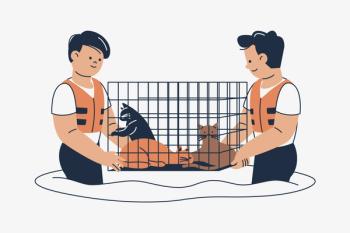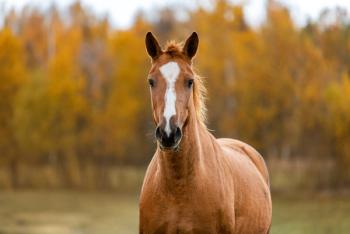
Dystocia in the mare: Manipulating a better outcome
When a foals improper placement is interfering with delivery, the practitioners success hinges on accurate determination of the cause and swift, appropriate intervention.
Figure 1. Dystocia in a mare. (All photos courtesy of Dr. Michael Spirito, Hagyard Equine Medical Institute)In horses, dystocia refers to any problem interfering with the normal birth of a foal, including improper placement of the foal in the birth canal requiring intervention, says Hagyard Equine Medical Institute veterinarian Michael Spirito, DVM (Figure 1).
Dystocia can occur in all breeds of horses. The best chance for a successful outcome depends on a prompt assessment of the cause followed by rapid intervention. Understanding the stages of labor and parturition is fundamental to these steps. Spirito describes these stages as follows:
Stage 1 labor. The mare shows signs of abdominal discomfort as the foal moves into the correct orientation, which consists of three parts: presentation, position and posture (Figure 2).
Presentation: Anterior longitudinal, with the foal's head presented toward the mare's vulva
Position: Dorsal sacral, describing the relationship between the foal's back and the mare's spine
Posture: Extension of the extremities, head and neck
Stage 2 labor. This stage, which shouldn't last longer than 30 minutes, begins when the chorioallantois ruptures and ends when the foal is expelled. It is also the point at which it's most important for the practitioner to decide whether to refer to a clinic or to continue attempting to reduce the dystocia.
Stage 3 labor. This stage is complete when the placenta is passed.
Figure 2. A foal with correct presentation, position and posture during stage 1 labor. (All illustrations adapted from Noakes DE, Parkinson TJ, England GCW, et al. Arthur's veterinary reproduction and obstetrics. 9th ed. Edinburgh, Scotland. Elsevier, 2009.)Initial points to ponder
When a mare presents with a dystocia, Spirito says practitioners need to first ask the following questions:
Will the mare allow me to freely palpate her?
What is the foal's viability?
What are my obstetrical skills?
Do I have the equipment and facilities I need to help the mare?
What are the client's financial constraints?
Once the practitioner feels comfortable moving forward, he or she needs to ascertain:
The mare's history
Whether this is the mare's first or second foal
The foaling date
How long the mare has been trying to foal
When the mare's water broke
Whether the mare is experiencing discomfort.
“Once these items are determined, I sedate the mare and clean her vulva and adjacent areas with water and betadine,” says Spirito. “I then wrap her tail up to keep it out of the way and to lessen the risk of contamination. With an assistant at her head and another at her tail, I then don a sleeve and palpate the foal.”
Spirito feels around for whatever he can locate first, which is usually the foal's head or often a front or a hind leg. From there, he begins manipulating the foal to determine its placement, which helps establish his next steps.
Figure 3. Assisted vaginal delivery of a standing, sedated mare.Dystocia intervention
According to Spirito, there are four procedures to solve a dystocia.
Manual manipulation. Assisted vaginal delivery, in which the practitioner manually manipulates the foal in a sedated, standing mare, should be attempted first (Figure 3). The practitioner should pull in time with the mare's uterine contractions to reduce trauma to both the foal and the mare and may find tools (such as a head snare or chains on distal limbs) helpful. Once the foal is properly positioned and the rib cage enters the pelvic canal, the mare should be allowed to finish delivering the foal herself to lessen the chance of fracturing the foal's ribs.
Controlled vaginal delivery. Controlled vaginal delivery should be done at a referral clinic with the mare under general anesthesia and in the Trendelenburg position, which utilizes gravity to repel the foal. The advantage of this procedure is that the foal can be repelled in a cranial direction with respect to the mare to allow more room for manipulation.
Cesarean section. When a dystocia cannot be resolved vaginally, the practitioner can perform a cesarean section with the mare in dorsal recumbency using a caudal ventral midline incision (Figure 4). Indications for this procedure include a severely malpositioned fetus, an abnormal birth canal or a need to reduce reproductive tract trauma.
Fetotomy. A fetotomy is reserved for a dystocia in which the foal is confirmed dead and cannot be delivered via vaginal manipulation.
Figure 4. A practitioner performing a cesarean section on a mare.
Most common dystocia presentations
Spirito outlines the most common dystocia presentations as follows:
Anterior presentations
1. Incomplete elbow extension occurs when the fetal hooves lie at the same level as the muzzle. Correcting this presentation involves repelling the fetal trunk as far as possible and then applying traction on one limb at a time, thereby positioning the foal in a more normal presentation (Figure 5-1).
Figure 5-1. Incomplete elbow extension.2. Dog sitting/hurdling position is characterized by apparent normal positioning, but the foal won't move. Upon further palpitation, the practitioner will discover one or two feet hind up (Figure 5-2).
Figure 5-2. Dog sitting/hurdling presentation.3. Carpal flexion/contracture is a common presentation that generally affects foals that are either quite large or that are contracted to some extent. To correct this presentation, the practitioner should pull the feet with a chain applied to the pastern with the carpus reflected laterally. A hand should guide the foot and the rotation should be gradual to avoid tearing the uterus (Figure 5-3).
Figure 5-3. Carpal flexion/contracture presentation.4. Foot over nape position occurs when one or both of the forelimbs are displaced over the head and against the roof of the vagina. Correcting this position involves repelling the fetus while the forelimbs are pulled under the head (Figure 5-4).
Figure 5-4. Foot over nape presentation.5. Head and neck lateral flexion is a common abnormality that is difficult to correct. If the fetus is alive, the practitioner should attempt to repel the foal and bring the head around (Figure 5-5).
Figure 5-5. Head and neck lateral flexion presentation.6. Head and neck ventral flexion can be fairly easy to correct if the fetal nose is just below the brim of the pelvis and the foal is not too large. Correcting this position involves applying pressure to poll and placing the snare on the lower jaw (Figure 5-6).
Figure 5-6. Head and neck ventral flexion presentation.7. Shoulder flexion may be unilateral (“swimming” position) or bilateral (“diving” position), and the fetal head can make access to the retained forelimb impossible. A cesarean section may be the only option (Figure 5-7).
Figure 5-7. Shoulder flexion presentation.
Posterior dystocia presentations
1. Hock flexion is typically bilateral. If the practitioner attempts to pull the foal, he or she risks rupturing the dorsal wall of the uterus. If the foal is small enough and there is adequate room, the position can be corrected using reduction. Otherwise, a cesarean section is called for if the foal is alive.
2. Bilateral hip flexion usually occurs with deformed foals. A cesarean section is generally preferred.
Ventral dystocia presentations
1. Anterior/ventral position is generally easy to resolve-even at the farm-though it's important to keep the head straight while rotating the foal and engaging it into the birth canal (Figure 6).
Figure 6. Anterior/ventral position.2. Posterior/ventral/extended posture carries a risk that the hind legs will penetrate the vagina or rectum. The practitioner can attempt to rotate the foal and deliver in a posterior position, but this is risky if the foal is large.
Transverse dystocia presentations
Transverse dystocia presentations aren't common and are most often associated with a congenital abnormality. Surgery or fetotomy may be necessary.
Today, equine practitioners have the tools, equipment and experience to treat mares presenting with dystocia far more effectively than in the past. Equine practitioners at Hagyard Equine Medical Institute and similar facilities, along with graduates of excellent equine programs at veterinary institutions across the country, routinely bring about successful outcomes in equine dystocia cases with limited downside if the condition is treated in a timely and appropriate fashion.
Suggested reading
Spirito MA. Review of how to triage a dystocia, in Proceedings. 62nd Annu Conv Am Assoc Equine Pract 2016; 6-12.
Noakes DE, Parkinson TJ, England GCW, et al. Arthur's veterinary reproduction and obstetrics. 9th ed. Edinburgh, Scotland. Elsevier, 2009.
Ed Kane, PhD, is a researcher and consultant in animal nutrition. He is an author and editor on nutrition, physiology and veterinary medicine with a background in horses, pets and livestock. Kane is based in Seattle.
Newsletter
From exam room tips to practice management insights, get trusted veterinary news delivered straight to your inbox—subscribe to dvm360.






